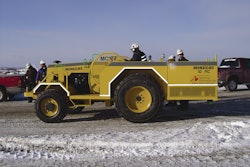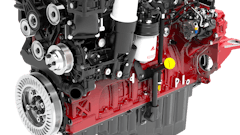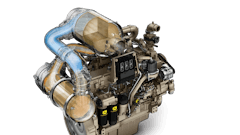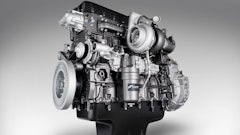When it comes to alternative fuels, you've read about ethanol, hydrogen and biodiesel. But, are you ready for a new fuel so abundant it could help the United States achieve energy independence and provide hundreds of years of transportation fuel — even as it lowered greenhouse gas emissions?
If you are, it is time to start thinking about coal — not your grandpa's coal, but liquid coal. More precisely, it is coal that has been converted to a liquid diesel fuel that is sulfur-free, emits fewer greenhouse gases than petroleum diesel and uses less energy to produce than ethanol.
"It is a natural fuel to address our energy concerns," says Corey Henry, a spokesperson for the Coal-to-Liquid Coalition, a consortium of coal producers, energy consumers, labor unions and coal-to-liquid (CTL) producers.
The U.S. Dept. of Energy estimates the nation has 286 billion tons of coal, which represents 95% of the nation's energy reserves, compared to 2 and 3% for oil and natural gas, respectively.
Coal itself is an inefficient source of energy that generates greenhouse gases and other pollutants when burned. Converting it to liquid diesel, however, turns it into an efficient form of energy that is very environmentally friendly. It produces minimal greenhouse gases and contains no sulfur — a principal component of particulate emissions.
Technology developed in 1920s
CTL technology has been around for more than 80 years and was explored commercially twice before — just after World War II and during the oil embargo of the 1970s. The discovery of cheap oil in the Middle East doomed the first attempt; the end of the oil embargo killed the second. Now, with oil prices stuck above $60 a barrel, developers and legislators are dusting off the manuals for the CTL process.
"CTL is commercially viable when oil is above $40 a barrel and most analysts predict oil won't fall back to that level any time soon, if ever," Henry says.
CTL is also becoming more attractive as ethanol loses some of its luster due to its high production costs, inferior gas mileage and its impact on corn prices. "The idea is catching on because [CTL] doesn't raise the price of beef or tortillas, because we have plenty of coal and because it keeps money in America," says John Rich Jr., president of Waste Management & Processors, Gilberton, PA, which has been advocating for the technology for more than a decade. Rich's firm has more than 100 million tons of culm, or waste coal, that it wants to convert to fuel using CTL.
While promising, CTL's future is far from certain. Its proponents will have to overcome coal's poor public perception, as well as environmentalists' negative knee-jerk reaction to anything related to coal.
Supporters are optimistic nonetheless. "We think there is a real appetite out there to lessen our dependence on foreign sources of fuel," says Henry. "It is a matter of awakening people to the technology. When they learn about it, they are surprised and heartened that we can convert this abundant resource into a clean fuel."
The most popular method for creating CTL diesel is the Fischer-Tropsch (F-T) process, which was developed by German engineers in the 1920s and has been a significant source of transportation fuel in South Africa since the 1980s.
In the F-T process, coal is heated to create a gas that consists primarily of carbon monoxide, hydrogen and carbon dioxide. The carbon dioxide is then removed and a metal catalyst is used to convert the remaining gas to a liquid that can be refined for use as diesel fuel, jet fuel and industrial chemicals.
Fewer emissions than oil-based diesel
The resulting fuel generates few particulate emissions because it contains no sulfur and few aromatics. Tests have shown that it generates 50% fewer hydrocarbon emissions, 50% less carbon monoxide and 30% fewer particulates than petroleum-based diesel. Like many diesel fuels, there are issues with lubricity and cloud points, but they can be remedied with additives.
While CTL diesel is more environmentally friendly than petroleum-based diesel, the F-T process itself generates a considerable amount of carbon dioxide — approximately double that produced by oil refineries. This has been seized by critics as a reason to avoid the fuel, but it overlooks the fact that the carbon dioxide doesn't have to be released into the atmosphere.
"A CTL plant won't be built unless it captures the carbon dioxide," says Henry. The captured gas can be sold for industrial processes or injected into the ground to improve oil recovery from existing wells, an established practice in the industry.
The generation of carbon dioxide can also be dramatically reduced by mixing coal with prairie grasses, switch grasses or crop residue during the F-T process. The biomass absorbs the carbon, preventing the creation of carbon dioxide. A study conducted by the RAND Corp. estimates that a 50/50 coal-biomass feedstock combined with carbon capture and sequestration could yield zero carbon dioxide emissions.
Returns could even be greater if researchers find a way to improve the diesel yield from coal. Currently, less than 60% of the CTL produced during the F-T process is suitable for transportation fuel. The remainder is used for chemical feedstock and other purposes. Researchers at Rutgers University and the University of North Carolina have identified catalysts that may be able to convert more of the coal into transportation fuel, but the concept hasn't been proven commercially.
Convincing Wall Street
Nor will CTL diesel replace petroleum-based diesel any time in the near future. Although more than a dozen plants are in the planning stages, no ground has been broken, and it will take three to four years to bring these plants on line.
One of the main problems is the financial community. "Even though South Africa has been using the technology for decades, Wall Street considers it an unproven technology because it hasn't been done commercially here," says Henry.
Rich agrees. "The bankers are wary because the learning curve hasn't been developed," he says. "I've got my site cleared and I am ready to go."
Rich has been waiting for awhile. The loan guarantees and other assurances he needs were included in the Energy Policy Act of 2005, but the Dept. of Energy has been moving at a snail's pace in implementing the provisions. "I am just waiting for the administration to do something."
CTL proponents are hoping that new legislation winding through Congress this summer will break open the financial log jam. One of the provisions being pushed is authorization for the Air Force to enter into a long-term, fixed-rate contract for the fuel.
"The Air Force is very interested in the fuel but they need congressional authority to proceed," says Henry. "If they get that authority, it will send a signal to Wall Street that there is a market, which will make it easier for developers to get financing."
Another legislative provision under consideration would establish floor and ceiling prices for CTL, which would protect producers from a drastic drop in oil prices. Under this voluntary program, the government would subsidize CTL producers if the price fell below a threshold — $40, for example — but would have to reimburse the government if the price exceeded a ceiling price, say $80 per barrel. The government would negotiate the specific prices with participating CTL producers. This would protect investors from a sustained drop in oil prices similar to what occurred when oil-producing nations drove down oil prices in the 1980s.
Given current oil prices, CTL is financially attractive. A recent Dept. of Energy study found that a "generic" CTL plant capable of producing 50,000 barrels per day would cost $3.65 billion to build and could achieve a 10% return on investment at $37 a barrel and 15% at $47 barrel. At $61 per barrel, the return would be almost 20%, which result in a five-year payback of the initial investment. At 100% capacity, the plant would produce 27,819 barrels per day of commercial-grade diesel and 22,173 barrels that could be used for chemical feedstock or other purposes.
But, even under the most optimistic scenarios, CTL plants will be producing between 2 million and 5 million barrels per day by 2030. That's not insignificant, but it would be less than 10% of the 21 million barrels of oil consumed by the United States each day.
Says Henry: "We won't see a significant use of CTL for awhile, but its potential is tremendous."
Dave Jensen is a contributing editor based in Milwaukee, WI.
















